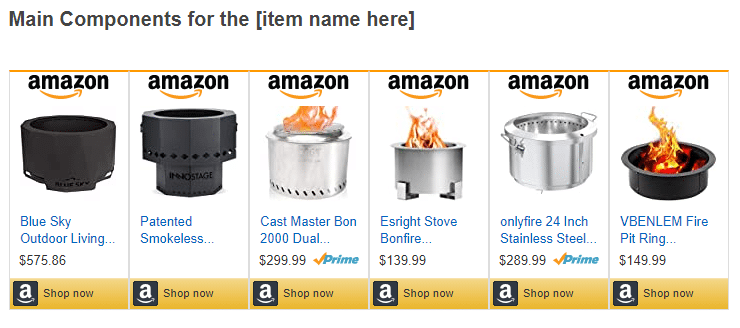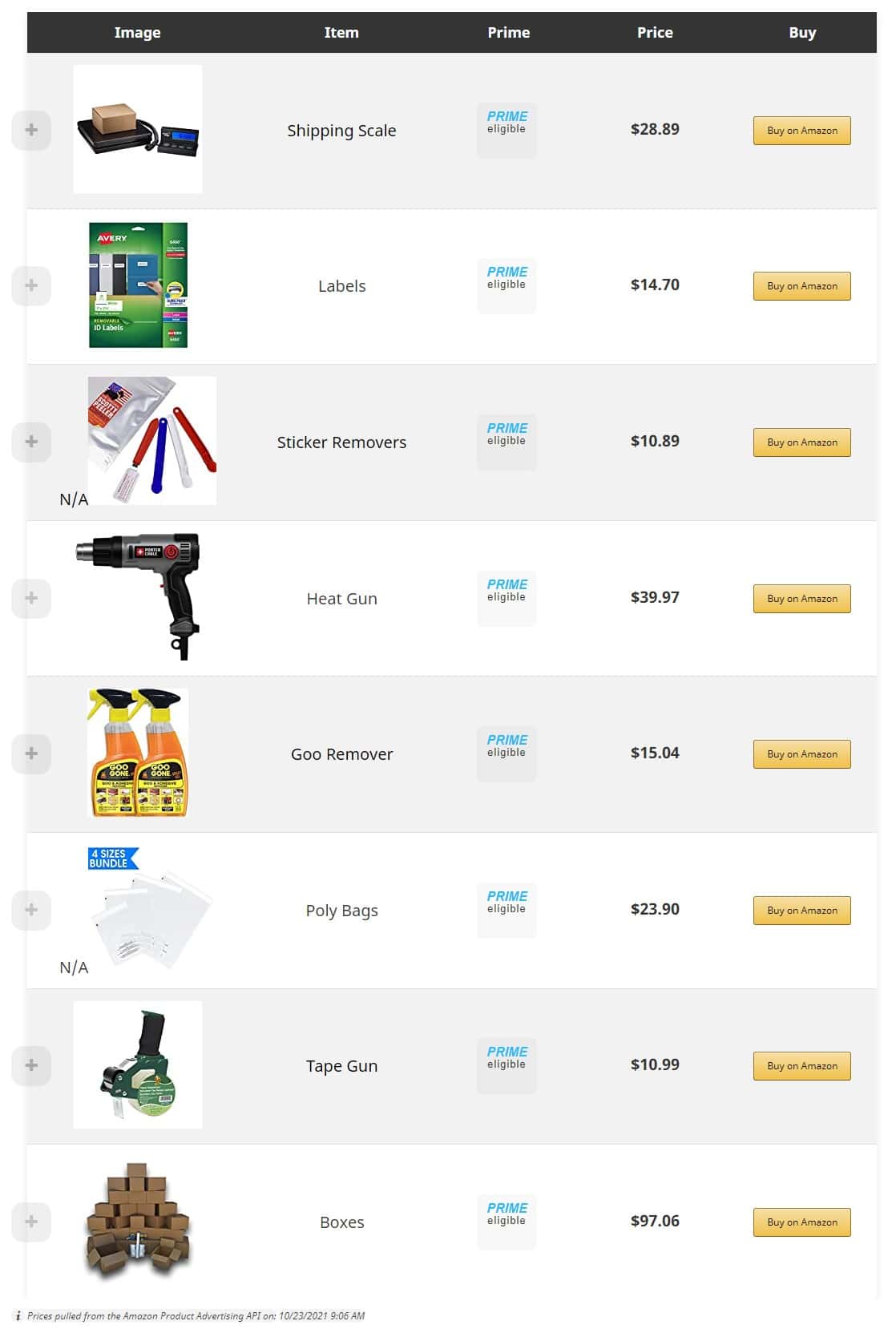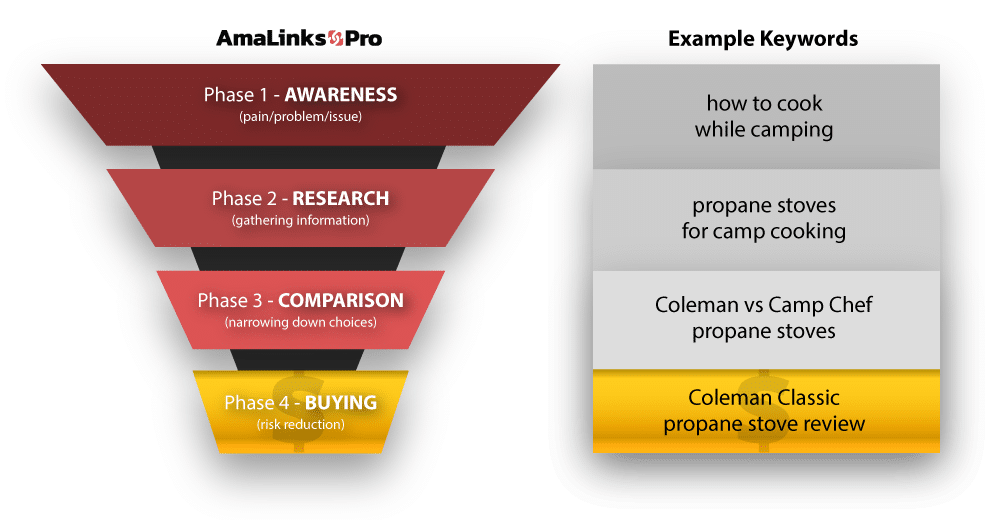7 Powerful Ways to Increase Amazon Affiliate Clicks on Your WordPress Site

When you buy something through one of the links on our site, we may earn an affiliate commission.
Over the years, it has become an almost daily routine for me to log in to my Amazon Associates account to check on my latest stats, affiliate sales, and earnings.
Some weeks and months are stellar with sales and earnings that exceed my expectations. Other weeks or months… not so much.
But one thing has always remained constant and consistent regarding my Amazon affiliate sales – the majority of the items that I get credit for are items that I don't even promote on any of my websites!
From my earliest days as a beginner Amazon affiliate (nearly a decade ago), to my peak days as an affiliate website creator, to today… I have been continually amazed by how many items I get credit for that I don't even promote. This is easily my favorite feature/benefit of the Amazon Associates program – the fact that they give you referral credit for ANY item purchased within 24 hours after your affiliate cookie is set.
It's THIS powerful affiliate program feature that gave me the idea to write this post about ways to increase Amazon affiliate clicks. And what better place to publish it, than on the Niche Pursuits blog!
Hey! Allow me to introduce myself.
My name is Matthew Allen and I am the co-founder and co-creator of AmaLinks Pro – easily the best Amazon affiliate WordPress plugin available on the market today.

If you want to learn more about my story, be sure to listen to my podcast interview with Spencer that we recorded about a year ago.
AmaLinks Pro has a great offer for Niche Pursuits readers.
Get 50% OFF the first payment for any of their plans!
GET YOUR AMALINKS PRO DEAL HEREContents
- Being a Product Creator in the Amazon Affiliate Space
- A/B Testing on Actual Affiliate Websites
- 1 – Don't Use Just Plain Text and Image Links
- 2 – Create Content that Teaches a Skill to Solve a Problem or Produce a Result
- 3 – Turn Off Display Ads on Affiliate Pages
- 4 – Insert Amazon Affiliate Links in ALL Types of Content
- 5 – Use Clear Call-to-Action Links or Buttons
- 6 – Product Comparison Tables with CTA Buttons
- 7 – Affiliate Content: Focus on Buyer-Intent Keywords
- More Awesome Tips for Amazon Affiliates
Being a Product Creator in the Amazon Affiliate Space
I feel like I am in a unique position for several reasons.
I've been a beginner Amazon affiliate. I've made all of the mistakes that so many beginners make. I've also been a successful Amazon affiliate. I've built up and sold successful affiliate websites. I've been a blogger for over a decade. I've written plenty of content for blogs that get no traffic and I've written quite a bit for blogs that get a lot of traffic. I've had some successes along the way and I've had more failures than I can count.
All of that stuff has been great. It has been such a fun journey as an internet entrepreneur. But everything I just mentioned is actually quite common. Lots of people do all of those things. The barrier to entry to become a successful blogger or affiliate website creator is quite low. It's not that difficult to pull off if you have the time and/or money to invest.
Being a successful product creator in the Amazon affiliate space though… now we are talking an entirely different ball game. The barrier to entry is much higher for a product creator and it is far more difficult to pull this off effectively and successfully. Nevertheless, I have done this as well and this is one of the top reasons that I feel like I am in a unique position to dole out advice on how to increase Amazon affiliate clicks on your website or blog.
Not only have I had my own share of affiliate websites and blogs – I've also seen hundreds of sites that monetize as Amazon affiliates over the past couple of years. I've been actively involved with our support team at AmaLinks Pro – and we've seen just about everything there is to see when it comes to websites or blogs that are monetized with the Amazon Associates program.
Why increase Amazon affiliate clicks on your website or blog?
I hope the answer is obvious – increased Amazon affiliate clicks typically lead to increased Amazon affiliate earnings!
As evidenced by my own decade-long observations within my own Amazon Associates account – most items that Amazon affiliates get credit for are items that they aren't even promoting.
In other words…
People are buying stuff on Amazon anyway!
Why not direct them to Amazon via your website or blog so you can earn more affiliate commissions?
If you've been following Spencer and Niche Pursuits for a long time, as I have, you likely are already aware of the typical tips and suggestions for increasing Amazon affiliate earnings. I will reiterate some of those strategies here. But I also hope to bring a fresh perspective to this space and offer up some less popular, yet very effective strategies.
Don't just take my word for it – Trust the science and the data!
Myself and Spencer and anybody else can spew out words of advice within a blog post like this very easily. But who's to say that we know what we are talking about?
Obviously, Spencer has a great reputation with several public case studies under his belt. He knows a thing or two. But what about me or anybody else who offers up advice like this? What proof do we have that our strategies to increase Amazon affiliate clicks will even work?
Well… I'm glad you asked. Because I wondered the exact same thing while testing different marketing strategies to sell AmaLinks Pro.
Why should anybody pay money for my WordPress plugin? What proof is there that it will actually help them get more clicks over to Amazon (resulting in more affiliate earnings)?
You see, at first – the main selling point that we had for AmaLinks Pro was just that it made life easier for Amazon affiliates. And it does! But after a while, we realized that just giving Amazon affiliates easier and better linking options was not enough. We already knew that our higher-converting link types performed better than the free options that Amazon gives us. But we needed to prove it.
Amazon Associates provides all affiliates with something called SiteStripe.

This gives you options to create text and image links within Amazon, then copy & paste those over to your WordPress website. We were made aware that there are actually people teaching that only text and image links are sufficient for Amazon affiliates. We're talking people who have very large followings!
So, we set out to find some of the followers of these teachers (online course creators). We specifically wanted to find followers who had blogs that were implementing this teaching – using only text and image links to promote Amazon products.
We found a few who were willing to give us access to their sites so we could run some A/B tests. The results that we came up with were astounding!
A/B Testing on Actual Affiliate Websites
First off – I should mention that this entire post and all evidence or advice within pertains ONLY to affiliate link clicks, not to affiliate earnings.
If you Google, “how to increase Amazon affiliate link clicks” – you won't find very many articles targeting this specific topic. Most articles highlight ways to “increase Amazon earnings” – and for good reason. Those are the types of keywords that people are actually searching for.
But here's the thing. You really can't definitively or accurately test and measure Amazon affiliate earnings based on changes that you make to your website or blog. We can measure clicks from our blog over to Amazon all day long. But, after a visitor gets over to Amazon, our affiliate earnings can vary drastically depending on their behavior once they get over to Amazon.
The reason being… Amazon gives referral credit for anything purchased within 24 hours – so, it is impossible to accurately test how earnings might be affected due to changes we make on our own websites or blogs.
Measuring the number of clicks over to Amazon is absolutely possible though – and can be accomplished in many different ways. We found a good WordPress plugin built specifically for A/B testing. We ran several tests on different people's websites and published all of the A/B Test results on the AmaLinks Pro blog.
Monitoring these tests on various sites over the course of several months, and then reporting on the data was enlightening. Being at the forefront of these tests is one of the top experiences that I have that has equipped me to divulge what I feel are some of the top strategies to increase Amazon affiliate clicks.
Here they are, in no particular order…
1 – Don't Use Just Plain Text and Image Links
This piece of advice became abundantly clear after the first three A/B tests that we ran.
It was painfully obvious that all three of these sites (different owners in different niches) were following the exact same template that somebody had taught to them. We were able to prove, without a doubt, that using just plain text or image links leads to serious underperformance when it comes to getting readers to click over to Amazon.
Here are links to the first 3 A/B tests that we ran and reported on:
- 256.4% Increase in CTR to Amazon on a Site in the Home Services Niche
- Amazon Affiliate: Plain Text and Image Links vs AmaLinks Pro (386% Increase!)
- 263% Increase in CTR to Amazon on a Site in the Health and Fitness Niche
I've heard and read the advice. I've seen the ‘talking heads' on YouTube who share this advice. “Just create great content and provide a text link at the end. Your readers will appreciate it and click on your link.”
I wouldn't be so sure about that these days. The majority of readers are now reading content from mobile devices. Clicking on tiny little text links is hardly the natural thing for readers to do.

But what about those images that link to Amazon. Everybody says to link images to Amazon to get more clicks! Oh really? And how are your readers supposed to know that the image is clickable (unless you tell them)?
It is not just my opinion that plain text and image links don't work very well to get people to click over to Amazon. After running several tests and seeing the data for myself – I can confidently say that it is a fact that plain text and image links are an ineffective way to get people to click over to Amazon.
2 – Create Content that Teaches a Skill to Solve a Problem or Produce a Result
This piece of advice is the result of being slapped in the face with a realization while setting up our fourth A/B test on another website. This realization is something that I guess I sort of already knew… but didn't fully grasp its power and effectiveness.
A guy wanted me to run an A/B test on a certain page on his site that was already killing it as far as clicks over to Amazon and Amazon affiliate commissions. The page was NOT a typical affiliate page at all. It was not a “best product for X” or “product name review” style post. Not even close! It did not list out products in a comparison format. In fact – it didn't even really talk about any products in detail at all!
So what kind of post was it then?
Without giving away the title of the post or giving too much other specific information… I'll just tell you that the post was instructional in format and showed how to build something in the survival/prepper niche. The original version of the post gave very specific instructions and listed out items and components for the project that could be purchased on Amazon. All links on the original version of the post were Amazon SiteStripe links. He literally used the SiteStripe Text+Image links, side-by-side, and it looked something like the example below.

Before we started the test – I admitted to the website owner that he was already doing an amazing job and that I was not certain that we could help him improve his click-through rate (CTR) to Amazon by simply swapping out his SiteStripe links with AmaLinks Pro links. However, I was absolutely certain that I could improve the look and flow on his page by removing the ugly SiteStripe Text+Image links that he was using and replacing those with AmaLinks Pro Showcase Boxes and Comparison Tables.
Here is an example of a comparison table built with AmaLinks Pro.

Tip: Comparison Tables can be used just to list out products – they don't actually have to compare products that are similar.
We ran the A/B test on this post for exactly 100 days, which saw over 13,000 page views. I guess I wasn't surprised – but I was quite pleased to report that we were able to increase his CTR to Amazon by 84% – despite his already great CTR numbers that he had in his original version of the post!
The takeaway here is that you don't always have to produce content around product keywords to generate Amazon affiliate commissions. In fact – you might do a whole lot better by producing helpful content that teaches people how to build something or produce a certain result. Simply show them products that are available on Amazon to help them achieve whatever it is that you are teaching. The Amazon affiliate links will almost be an afterthought – but it works amazingly well!
3 – Turn Off Display Ads on Affiliate Pages
This piece of advice could be slightly controversial and might be better described as opinion rather than actual advice.
As somebody who sees a lot of websites attempting to monetize with Amazon affiliate links – I am continually bewildered when I see obvious product affiliate pages that also have obnoxious display ads all over the place.
This might be just a matter of opinion on my part. If you want more affiliate link clicks, remove any other distractions – especially display ads! It's kind of like something you would learn in – building a checkout page 101 – remove ALL other distractions and let the user complete the checkout process. The execution is slightly different for affiliate links, but the concept is generally the same.
I mean… if you're making more money with display ads, then by all means – keep the display ads!
This begs the question of whether you should be attempting monetization with Amazon affiliate links at all. But if you do want to increase clicks over to Amazon – then I would suggest removing display ads just on pages where Amazon monetization is the #1 goal.
This is not something I have tested personally. Every site is very different and all will perform differently, by far. You should always test, test, test… Then keep the version that works best for you and your website.
4 – Insert Amazon Affiliate Links in ALL Types of Content
This piece of advice stems from personal experience, as well as observation.
Many Amazon affiliates are led to believe that they need to produce ‘product review' type posts, or ‘best product for x' type posts, in order to earn decent Amazon affiliate commissions. These types of posts are commonly known as affiliate content – where the obvious intent of the post is to promote products as an affiliate.
I'm here to tell you that it is possible to earn great commissions from Amazon with ALL types of content – not just affiliate content. As evidenced in tip #2 above, you can earn phenomenal commissions from Amazon without having to review or compare products.
Tip: Personalize your content by telling a story and making it interestingly readable.
Here is an example from my personal Dumb Passive Income blog…
In one of my weekend update posts, I told a short story about how our neighbors had given us a 3D pen that they no longer needed/wanted and that my son had spent hours making different creations with it.
I posted two front & back pictures of a robot that he made with the 3D pen – then posted a Showcase Box promoting a similar 3D pen on Amazon right after that. Next thing you know – 2 of those 3D pens showed up as purchased items in my Amazon Associates dashboard!
Here are the pictures of the robot that my son created with the 3D pen.

Here is what an AmaLinks Pro Showcase Box might look like, that promotes a similar 3D pen.

There are a lot more different types of content that can easily be monetized with Amazon Associates.
I wrote a great post on the AmaLinks Pro blog about how to monetize ANY blog post with Amazon Associates. Within that post – I list out several different post types and give examples. I also share tips at the end of the post regarding the nuts and bolts of monetizing with Amazon Associates.
Here are a few of the post types mentioned in the post:
- list posts
- how-to guides (tutorials)
- checklists (cheat sheets)
- interviews
- guest blogging
- newsworthy articles
The general idea here stems back to one of the opening statements I made in this blog post. “People are buying stuff on Amazon anyway! Why not direct them to Amazon via your website or blog so you can earn more affiliate commissions?”
All you need to do is strategically place Amazon links in as much of your content as possible. Many people will click over to Amazon and then you will earn commissions for anything they buy within the next 24 hours.
AmaLinks Pro is giving our audience 50% OFF any new sign-ups!
It's for a limited time only, so get in quick.
GET YOUR AMALINKS PRO DEAL HERE5 – Use Clear Call-to-Action Links or Buttons
This piece of advice stems from the analytical data as described in tip #1 above, but I want to discuss the idea in a more practical manner.
We have the proof and the data showing that plain text and image links underperform as compared to higher-converting link types, like Showcase Boxes, CTA Buttons, and Comparison Tables.
Here is another example of a ‘Simple Showcase Box' from AmaLinks Pro.

But why do those link types perform better?
The answer is right in front of us – right there in the H2 subheading for this section: Use Clear Call-to-Action Links or Buttons!
When a reader sees a call-to-action (CTA) button that says something like, ‘Buy on Amazon' – it is extremely clear that they are supposed to click the button to view the product on Amazon. Text links can also clearly tell a reader what to do – but a CTA button practically screams at the reader… CLICK ME NOW!!!
Here is an example of a CTA Button, built with AmaLinks Pro, that Spencer uses on Own The Yard.

Don't assume that your readers know exactly what to do. Sometimes you need to give them very specific calls-to-action or instructions.
For example, I always make the images in my comparison tables clickable, and then I typically include the following phrase just above each of my comparison tables: ‘Click on ANY image in the table below to see ratings and reviews on Amazon.'
It's not a bad idea to sprinkle in several text links, in addition to higher-converting link types (like Showcase Boxes). Be sure to use clear instructions in your text so your readers know that the link is clickable and will take them over to Amazon to view the product.
For example: ‘CLICK HERE to check the current price on Amazon.'
What about plain image links?
People always say you should link your images to Amazon to increase your CTR's. But, how are people supposed to know that your images are even clickable? Are you hoping for an accidental click?
Here's what I do. I typically use large images – center-aligned – then center align a nice CTA Button or some plain text just underneath the image. The CTA Button itself is clickable and links to Amazon. Or, the plain text could simply read, ‘Click on the image above to see more product images on Amazon.'
The point here is obvious. You should be using very clear calls-to-action throughout ALL of your content. Make sure to have a CTA towards the top (many readers will never scroll all the way to the end).
Use more CTA's and links throughout the content, wherever and however it makes sense. And by golly – be absolutely certain to include a bold and clear CTA (with buying words) at the very end. For those readers who make it all the way to the end – you need to definitively tell them what to do next (go to Amazon).
6 – Product Comparison Tables with CTA Buttons
This piece of advice is derived from personal experience as well as research and observation in the affiliate marketing space for nearly a decade. For the love of Pete (I don't know who Pete is…), use product comparison tables in your posts to increase your CTR's over to Amazon!
Maybe it's a psychological thing… but there's just something about a comparison table that makes the reader want to click. Especially if the comparison table includes CTA buttons (and it really should) with an extremely clear and bold call-to-action.
- Buy Now on Amazon
- Check Price on Amazon
- See Reviews on Amazon
- Learn More on Amazon
- See Options on Amazon
If your post is a review post about one specific product, use a comparison table to show how it compares to other similar products.
If your post is a ‘best product for x' type post, where you mention several products within – a product comparison table is a no-brainer and almost a must!
If your post is a tutorial or how-to post – use a comparison table not to compare, but instead to list out items needed to complete the project.
Here is an example of a table that I built on an ‘FBA Seller – Tools and Supplies‘ page on my Dumb Passive Income blog.

If built correctly, product comparison tables can enhance the user experience on your website pages (or posts) while increasing your CTR's over to Amazon at the same time. It's really a win-win!
7 – Affiliate Content: Focus on Buyer-Intent Keywords
This piece of advice stems from behavioral analysis in what is known as the 4-phase buying cycle.
If you are producing affiliate content for your website or blog – you really should have at least a basic understanding of the 4-phase buying cycle. It looks something like this…

- Phase 1 – Awareness (pain/problem/issue) Ex: how to cook while camping
- Phase 2 – Research (gathering information) Ex: propane stoves for camp cooking
- Phase 3 – Comparison (narrowing down choices) Ex: Coleman vs Camp Chef propane stoves
- Phase 4 – Buying (risk reduction) Ex: Coleman Classic propane stove review
Most advice in this space will tell you that best [product] for x or [vague product] reviews type keywords are buyer-intent keywords.
Sure – these types of keywords do drive a lot of traffic (because they have a lot of search volume) and affiliates who rank for these keywords do rake in some good commissions. But, if you understand the 4-phase buying cycle, these actually are not buyer-intent keywords. Many best… or …reviews keywords actually fall within phase 2 or phase 3, the research and comparison phases.
Here are two more examples of common keywords that affiliates might target in this category…
- best propane stove for camp cooking (research phase)
- propane stove reviews (comparison phase)
Let's take a look at what an actual buyer-intent keyword looks like in this example. A person who has already completed the first 3 buying phases for this example might search for the following keyword if they are in phase 4, the buying phase…
- Coleman Classic propane stove review
This is absolutely a buyer-intent keyword!
Maybe they've already done their research and made their comparisons – and now they just want to see some reviews on the specific Coleman Classic propane stove before they make the purchase. Somebody who searches for a specific product like this will likely find a page that targets and reviews the Coleman Classic propane stove, specifically (click that link to see an example review post for the Coleman Classic propane stove).
Again – targeting keywords in the research and comparison phases seems to work well for Amazon affiliates. Sales do occur and commissions are earned. But – targeting keywords in the buying phase is easily the most powerful way to really generate commissions from your affiliate content.
If you can rank for these types of keywords and get traffic – you will literally be intercepting buyers who are likely on their way to Amazon anyway to make the purchase.
More Awesome Tips for Amazon Affiliates
The 7 tips detailed above are some of my best when it comes to showing affiliates how to increase clicks to Amazon on WordPress sites. I realize that it's kind of a lot to digest in one long blog post like this.
Furthermore – I have SO many more tips and advice that I would love to share with you. If you're interested, I have a cool way to deliver the information to you in bite-size chunks.
It's something we call The Level Up Series (from AmaLinks Pro). It's a Masterclass for Amazon Affiliates – delivered as an email series.
SIGN UP HERE FOR THE LEVEL UP SERIESYou will receive actionable advice, templates, and strategies that you won't find anywhere else!
In addition, you will be introduced to the most powerful and increasingly most popular WordPress plugin for Amazon affiliates – AmaLinks Pro! I can't wait to see you on the other side.
Get 50% OFF your first Amalinks Pro payment.
Limited Time – For this week only!
GET YOUR AMALINKS PRO DEAL HEREWant to learn step-by-step how I built my Niche Site Empire up to a full-time income?
Yes! I Love to Learn
Learn How I Built My Niche Site Empire to a Full-time Income
- How to Pick the Right Keywords at the START, and avoid the losers
- How to Scale and Outsource 90% of the Work, Allowing Your Empire to GROW Without You
- How to Build a Site That Gets REAL TRAFFIC FROM GOOGLE (every. single. day.)
- Subscribe to the Niche Pursuits Newsletter delivered with value 3X per week
My top recommendations
















